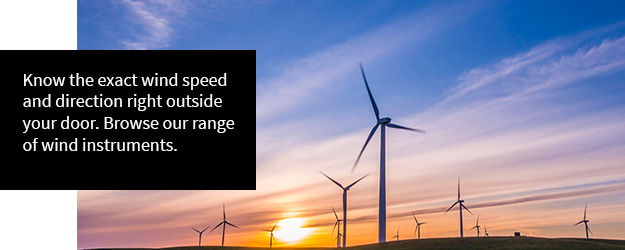Wind Direction Instruments: Types, Uses & How They Work
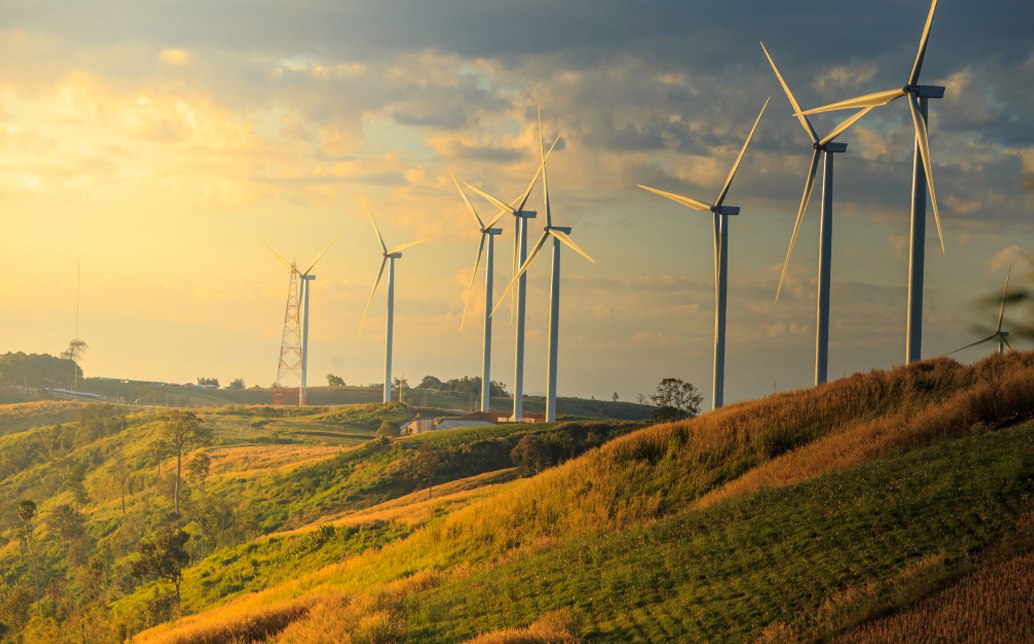
Wind speed and direction are two of the many variables that meteorologists keep track of when observing the weather. The speed and direction of the wind can hold vital clues to understanding the weather and play a major role in forecasting future conditions. There are also many benefits to tracking wind speed and direction at your home.
Key Takeaways
- Wind direction instruments measure where wind is coming from (not going to)
- Various instruments serve different purposes – wind vanes show direction, anemometers measure speed, wind socks provide visual indicators, and sophisticated wind profilers track conditions at multiple altitudes.
- Understanding wind direction helps predict approaching weather systems, as winds from different directions typically bring distinct temperature and humidity conditions to your area.
- Wind monitoring is essential across numerous industries, including aviation, agriculture, construction, and renewable energy, where accurate measurements can prevent accidents and optimize operations.
What is a Wind Direction Instrument?
A wind direction instrument, also known as an anemoscope, is a device specifically designed to indicate the direction from which the wind is blowing. The most common and historically significant type is the wind vane (or weathervane), which has been used for over two millennia to help people understand local wind patterns. Modern wind direction instruments range from simple mechanical devices to sophisticated electronic sensors that provide precise directional data.
These instruments are essential tools for meteorologists, sailors, pilots, farmers, and weather enthusiasts who need to monitor and predict weather patterns. When combined with other weather measurements like wind speed, temperature, and barometric pressure, wind direction data helps create a comprehensive picture of current conditions and potential weather changes.
What Does Wind Direction Mean?
Wind direction is a meteorological term that refers to the compass point from which the wind originates—not where it’s heading. Don’t worry, it is just as confusing as it sounds. For example, a northerly wind comes from the north and blows south. A southwesterly wind comes from the southwest and blows northeast.
Understanding wind direction is crucial because it provides valuable information about approaching weather systems. For instance, in many parts of the United States, winds from the south often bring warmer, more humid air, while winds from the north typically bring cooler, drier conditions. Coastal areas may experience onshore breezes (from sea to land) during the day and offshore breezes (from land to sea) at night, affecting local temperatures and humidity levels.
Wind direction is typically reported using either the cardinal directions (north, east, south, west) and their intermediate points, or in degrees, where 0° or 360° represents north, 90° east, 180° south, and 270° west.
Is the Wind Direction to or From?
Wind direction is all about where the wind is coming from, not where it’s headed or going to. This convention is used universally in meteorology and navigation to maintain consistency in weather reporting and forecasting. When a weather report mentions a “northerly wind,” it indicates that the wind is blowing from the north toward the south.
This “from” convention has practical origins. Sailors and farmers have always needed to know where the weather was coming from so they could get ready for what was on the way. A wind blowing from the west, for example, would bring whatever weather systems were developing to the west.
Understanding this distinction is particularly important when interpreting weather forecasts or using your own wind direction instruments. If your wind vane points east, it indicates an easterly wind, meaning the air is moving from east to west. This knowledge helps you anticipate weather changes and make informed decisions about outdoor activities, travel plans, or agricultural operations.
Why Does Wind Direction Matter?
Wind direction matters because it can cause weather changes. With the right conditions, bad weather can cause secondary hazards such as storm surges, floods, and severe thunderstorms. Determining wind speed and direction is also important for military use. The United States Air Force collects data by dropping cargo with sensors during a simulated resupply drop, which then transmits coordinates as it falls to the ground. Knowing when a cargo drop is to be expected and where it should land is critical information for soldiers on the battlefield.
Technological advances have significantly enhanced the accuracy of such devices. Various types of wind monitoring instruments may be used for measuring many different variables, including the direction and velocity of the wind.
Instruments and Devices to Measure Wind Speed
Accurately measuring wind speed is crucial for various applications, including weather forecasting and aviation safety. Several types of instruments have been developed over the years to provide reliable wind speed measurements in different environments and for different purposes.
Let’s take a look at some examples below.
Cup Anemometer
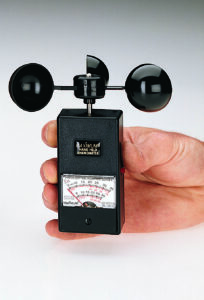
The cup anemometer is one of the most popular types of wind monitoring devices, and the style that Maximum uses for its instruments. It is designed to measure the speed of wind.
Outfitted with three or four small hemispheres or cups installed on arms, this device catches the wind. An electrical piece is used to record the number of revolutions that the cups make and then calculate the speed of the wind.
These types of wind monitoring devices can prove to be beneficial in determining weather patterns and predicting approaching weather patterns. Cup anemometers are commonly used at weather stations and in other areas where it is important to measure wind speed, like airports.
Common Use Cases for Anemometers
- Airports and hospitals measure wind speed to ensure a safe take-off and landing of an aircraft or helicopter.
- Weather stations measure wind speed to detect a change in weather patterns, such as an approaching storm.
- Real estate drone photography is a popular way to showcase property. Wind speed can vary at different heights and a sudden burst of wind can make it a costly flight.
- Farmers measure wind speed to determine suitable days for spraying or dusting crops.
Wind Vane
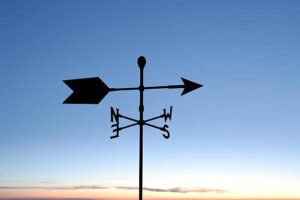
A wind vane (also known as a weathervane) is a wind direction instrument that has been around for more than 2,000 years, and it was invented by the Greek astronomer Andronicus in 48 B.C. A wind vane is an instrument that shows you the direction of where the wind is coming from. Wind vanes are simple in design, the most common being an arrow. They consist of an arm with a fin. As the wind blows, the tail catches the wind, which moves the nose (tip of the arrow) and points in the direction the wind is coming from. To make a proper reading of wind direction, it’s important to use a compass when installing your wind vane. Even though the wind vane is over 2,000 years old, it’s still highly functional, useful, and can be added as a decorative piece to your home.
Wind Alarm
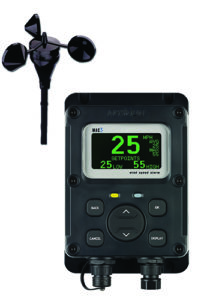
Wind alarms are another type of wind monitoring tool. Designed to give an indication to the user that the wind has reached a certain speed, this type of device may be configured by the user and can produce analog outputs. Alarms may contain a variety of different features, including adjustable time delays, the presence of two alarms, or a security code.
Common Industries That Use Wind Speed Alarms
- Construction
- Agriculture
- Renewable Energy
- Mining
- Aviation & Marine
How to Choose a Wind Speed Alarm
In choosing wind speed and direction instruments, many different factors will need to be taken into consideration. Along with having a rugged construction, the instrument should also feature an aerodynamic design. It is also important to ensure you choose a device that is known for its accuracy and repeatability. Depending upon your needs, it may also be necessary to procure a mounting accessory for the device that you choose.
Wind Sock
A windsock is a tapered, hollow cone made of fabric that visually indicates both wind direction and approximate wind speed. When air flows through it, the sock fills with wind and points away from the direction the wind is coming from. This simple yet effective device is used primarily at airports, heliports, and chemical plants where quick visual assessment of wind conditions is essential.
While wind socks don’t provide precise numerical measurements, they offer valuable at-a-glance information. The extent to which the sock extends horizontally indicates the relative wind speed—a fully extended sock typically represents winds of 15 knots (about 17 mph) or greater, while a partially extended sock indicates lower wind speeds.
Wind socks are particularly valuable in environments where quick visual assessment is necessary, such as for pilots during takeoff and landing. They’re also commonly used at beaches, marinas, and outdoor sporting venues to help participants gauge wind conditions. Their simplicity makes them reliable even in harsh weather conditions or power outages when electronic instruments might fail.
Wind Profiler
A wind profiler is a sophisticated remote sensing instrument that measures the profile of wind speed and direction at various heights throughout the atmosphere, typically from near ground level up to several kilometers. Unlike surface-based instruments that only measure winds at a single point, wind profilers provide valuable data about how wind conditions change with altitude.
These instruments use either radio or sound waves (RADAR or SODAR technology) to detect the movement of particles in the air. By analyzing the Doppler shift in the returned signal, wind profilers can determine both wind speed and direction at multiple levels simultaneously.
Wind profilers are particularly important for:
- Weather forecasting, as they help meteorologists understand complex atmospheric conditions
- Aviation safety, providing pilots with crucial information about wind shear and turbulence at different altitudes
- Air quality monitoring, helping track how pollutants might disperse in the atmosphere
- Renewable energy development, assisting wind farm designers in determining optimal turbine heights
While home weather stations usually don’t have this type of equipment, the data from wind profilers is important for the forecasts we rely on.
Take Your Weather Tracking to the Next Level
Wind direction instruments have evolved significantly from the simple weathervanes of ancient Greece to today’s sophisticated electronic sensors and profilers. Whether you’re an outdoor enthusiast, sailor, farmer, or aviation professional, understanding wind patterns provides valuable insights for decision-making and safety.
Modern wind measurement tools combine functionality with precision, allowing anyone to monitor local conditions with accuracy previously available only to professional meteorologists. By investing in quality wind direction instruments for your home or business, you gain not just data but the ability to anticipate and prepare for changing weather conditions, turning ancient wisdom into a practical, everyday advantage.
Additional Resources
- Wind Speed Alarms at Work
- What is Atmospheric Pressure and How is it Measured?
- What is a Nor’Easter and Why The Name?
If you’re looking for a 3-in-1 solution for measuring wind speed, direction, and wind gust in real-time, Maestro is the answer. Also, check out our other weather instruments or contact us today.

